

Plants in Space. Content in this section supports the concept of growing crops in space and the symbiotic relationship between plants and space travelers.

Plants in space are beneficial for a number of reasons. They provide nourishment for the body when eaten as food, and they improve the quality of indoor air. Plants take the carbon dioxide from air to produce oxygen that humans can breathe. Find information about how plants, people, microbes and machines work together in self-contained space vehicles.
Light Management for Controlled-Environment Agriculture. Cornell’s greenhouse project delivers tons of hydroponic lettuce grown under a computerized lighting system.

Imagine harvesting crops in New York state in the dead of winter. At Cornell University, a hydroponic greenhouse project is making that happen. In the controlled environment, it takes 35 days to grow one head of hydroponic lettuce, yielding a potential harvest of 390 tons an acre per year. That’s a lot more than the 45 tons of in-ground lettuce per acre per year grown in California and harvested from three crops. Central to the Cornell project is the greenhouse’s computerized lighting system. In one way, plants “see” the world much as humans do. Specific wavelengths outside the photosynthetically active radiation band are important for morphological and flowering responses, but actual photosynthesis and growth are based on the number of photons (expressed as moles) received within the photosynthetically active radiation spectrum. Figure 1. Retrofit kits - Aurora Puck Kits - Rapid LED.
Custom LED Strip - BML Custom. Technical Documents. Photometry and Photosynthesis. From Illuminance to PPFD Ian Ashdown, FIES Chief Scientist, Lighting Analysts, Inc. [ Please send comments to allthingslighting@gmail.com ] UPDATE 15/04/13 – This article was first published on December 10, 2014.
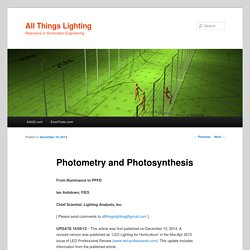
Light Measurement. Illumia® Labsphere's flagship line of light measurement solutions: choose from handheld devices to modular integrating sphere systems ranging in size from 25cm to 3m.
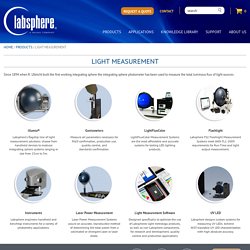
Goniometers Measure all parameters necessary for R&D confirmation, production use, quality control, and standards confirmation. LightFluxColor LightFluxColor Measurement Systems are the most affordable and accurate systems for testing LED lighting products. Flashlight Labsphere FS2 Flashlight Measurement Systems meet ANSI FL1-2009 requirements for Run-Time and light output measurement. Instruments Labsphere engineers handheld and benchtop instruments for a variety of photometry applications.
Laser Power Measurement Laser Power Measurement Systems assure an accurate, reproducible method of determining the total power from a collimated or divergent laser or laser diode. LI-COR Environmental. Led horticoles. Photosynthèse - Spectre Photosynthétique - leoLED Europe. Economic Analysis of Greenhouse Lighting: Light Emitting Diodes vs. High Intensity Discharge Fixtures. Abstract Lighting technologies for plant growth are improving rapidly, providing numerous options for supplemental lighting in greenhouses.
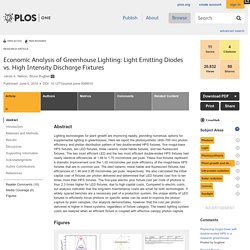
Here we report the photosynthetic (400–700 nm) photon efficiency and photon distribution pattern of two double-ended HPS fixtures, five mogul-base HPS fixtures, ten LED fixtures, three ceramic metal halide fixtures, and two fluorescent fixtures. The two most efficient LED and the two most efficient double-ended HPS fixtures had nearly identical efficiencies at 1.66 to 1.70 micromoles per joule. How To Compare Grow Lights. If you are not familiar with the differences in PAR, PPF and PPFD – please read our article first to get the most out of the rest of the information provided here.
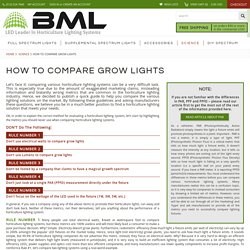
As a refresher, PAR (Photosynthetically Active Radiation) simply means the light a fixture emits will promote photosynthesis in a plant. Important - PAR is not a metric; it is simply a type of light. PPF (Photosynthetic Photon Flux) is a critical metric that tells us how much light a fixture emits. It doesn’t measure the intensity at any location, but it tells us how many photos are coming out of the light every second. PPFD (Photosynthetic Photon Flux Density) tells us how much light is falling on a very specific location (i.e a specific leaf on your plant) every second. Photomorphogenesis Guide and Information. Considerations for Horticulture Lighting Beyond Photosynthesis There are certain important requirements for horticulture lighting, which are in addition to those for photosynthesis.
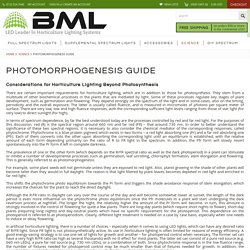
They stem from a multitude of other biochemical processes in the plants that are mediated by light. Some of these processes regulate key stages of plant development, such as germination and flowering. They depend strongly on the spectrum of the light and in some cases, also on the timing, periodicity and the overall exposure. The latter is usually called fluence, and is measured in micromoles of photons per square meter of surface.
In terms of spectrum dependence, by far the best understood today are the processes controlled by red and far red light. Photosynthesis Guide and Information. Photosynthetic Considerations for Horticulture Lighting There are certain important considerations when choosing a light source for horticulture lighting.
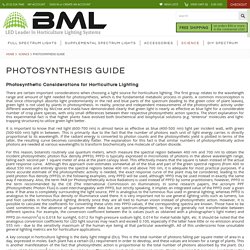
The first group relates to the wavelength range and amount of light needed for photosynthesis, which is the fundamental metabolic process in plants. A common misconception is that since chlorophyll absorbs light predominantly in the red and blue parts of the spectrum (leading to the green color of plant leaves), green light is not used by plants in photosynthesis. In reality, precise and independent measurements of the photosynthetic activity under different wavelengths by McCree and Inada have demonstrated clearly that green light is nearly as effective as blue light for a considerable number of crop plant species, with only small differences between their respective photosynthetic action spectra.
GrowSmart LED Grow Light Spectrum Controller Kit. Model/SKU: GrowSmart LED Grow Light Controller – GS-SC Daisy Chain: For use with up to 10 units (or max 2000W) using the GrowSmart controller Additional Details: 3 programmable channels (Grow, Veg, Bloom), use controller to independently manipulate the 3 channels Warranty: 3 years on the Grow Light Controller, 1 Year on Remote The range of GrowSmart LED modules feature independent and customisable spectrum channels (Grow, Vegetation and Bloom/Flowering) that allow you the flexibility to create the right timing, blend of spectrum and intensity for all phases of growth and plant types by the hour.

Used in conjunction with the GrowSmart LED grow light controller, each LED spectrum channel can be independently adjusted for every hour of the day in a 24 hour cycle. Systèmes & composants. La lumière, la couleur et les plantes - Led horticoles. Comme vous devez déjà le savoir, les longueurs d'onde constituant une lumière, donc son spectre, ont une influence directe sur la santé et le développement de vos plantes.
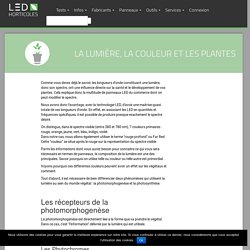
Cela explique donc la multitude de panneaux LED du commerce dont on peut modifier le spectre. Nous avons donc l'avantage, avec la technologie LED, d'avoir une maitrise quasi totale de ces longueurs d'onde. En effet, en associant les LED en quantités et fréquences spécifiques, il est possible de produire presque exactement le spectre désiré. On distingue, dans le spectre visible (entre 380 et 780 nm), 7 couleurs primaires : rouge, orange, jaune, vert, bleu, indigo, violet.
Dans notre cas, nous allons également utiliser le terme "rouge profond" ou Far Red. Parmi les informations dont vous aurez besoin pour connaitre ce qui vous sera nécessaire en termes de panneaux, la composition de la lumière est une des principales. Voyons pourquoi ces différentes couleurs peuvent avoir un effet sur les végétaux et comment. Il sert à :
Semences-Partage.net - Information. Guides - Led horticoles. Intelligent-Gro II Intensity Series 180w LED Grow Lights- - Intelligent Gro LLC. General Info: Minimum height of 14"-16" from the canopy during flowering. Naturally Innovative. Photosynthesys.
Divers culture. SDEC France > Tarières et outils agronomie environnement Science du sol. Mesure du rayonnement photosynthétiquement actif. Description Ce capteur mesure le rayonnement photosynthétiquement actif (appelé aussi capteur P.A.R.) compris entre 400 et 700 nanomètres. Le niveau de sortie de ce capteur est proportionnel au nombre de photons reçus dans la bande considérée, indépendamment de leur niveau d'énergie. Capteur par pour WatchDog. Pyrano.pdf. PQS 1 Capteur PAR Quantum - Kipp & Zonen. Le capteur PAR Quantum PQS 1 a été conçu pour une mesure précise du rayonnement photosynthétique actif, grâce à Son excellente correspondance avec la réponse PAR. De plus, le design optique du diffuseur garantit une correction cosinus optimisée. Ce capteur est prévu pour un fonctionnement en milieu extérieur ou intérieur, comme pour la culture sous serre par exemple.
Le rayonnement solaire et artificiel (avec des lampes sodium haute pression) représentent une source de rayonnement photosynthétique actif. La sensibilité du PQS 1 a été optimisée pour fournir des mesures fiables et précises quelle que soit la source PAR. DeltaOhm - Analyse Météo - Mesures radiations solaires. PHOTOLOGIE FORESTIERE.